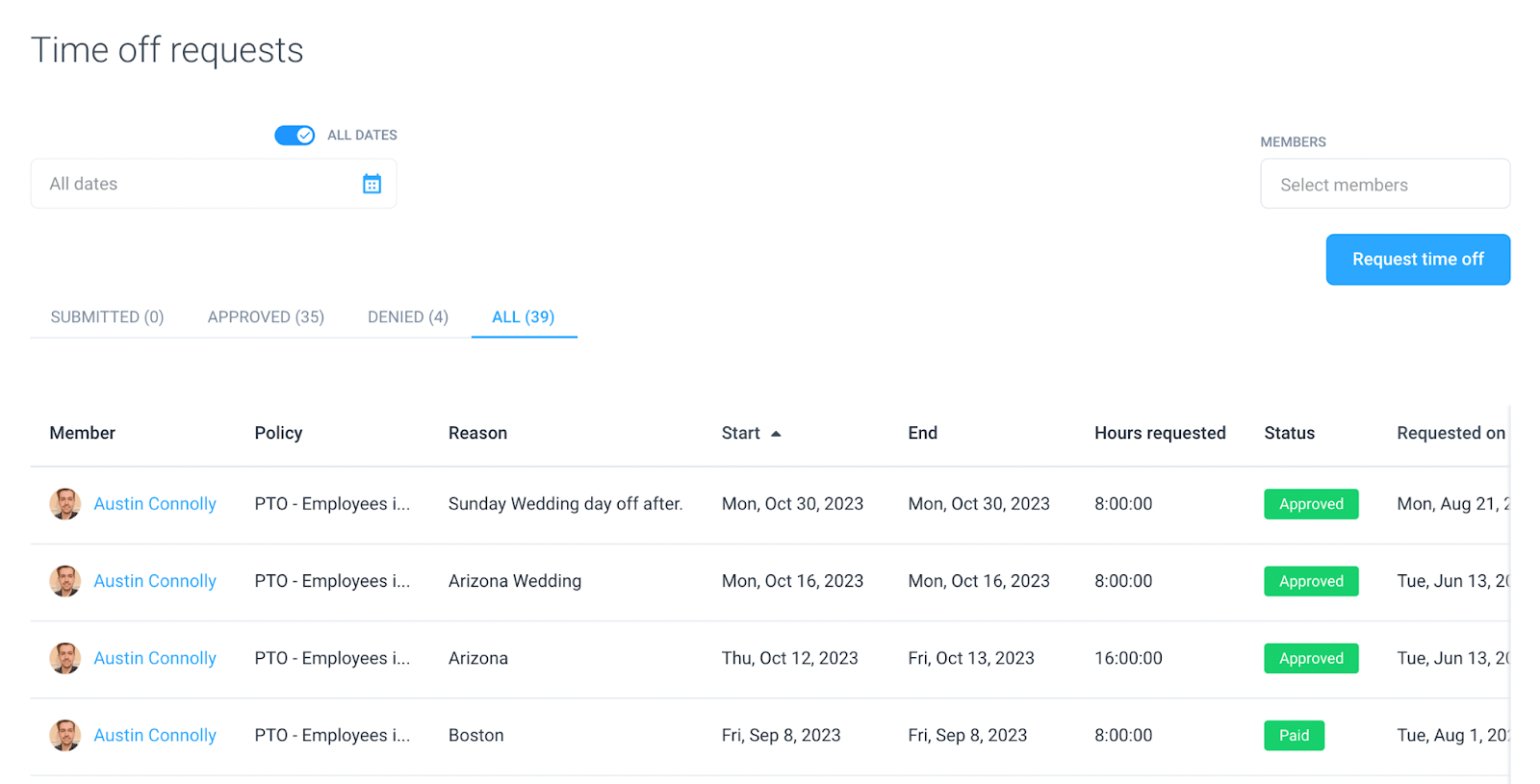Companies are shifting to unlimited PTO — but employees can’t take every day off. So, what gives PTO meaning in the modern work landscape?
Traditional vacation, sick leave, and other types of time off policies are losing their luster. As a result, businesses and employees alike are rethinking these policies. Should you join the fray and switch to a more progressive PTO policy?
The only way to answer these questions is to understand the difference between PTO and vacation. We’ll cover this topic in detail so you can implement the best policies for your business to simplify your processes and boost morale and productivity.
Boost your team’s efficiency with Hubstaff's productivity tools
What is PTO?
PTO refers to the policy that allows employees to take time away from work and still receive their regular pay. This concept is broad and can encompass a variety of scenarios, such as vacations, personal time, or illness.
PTO policies may vary between companies and can be affected by state and federal laws. For example, in the United States, no federal law guarantees paid vacation or personal time, although laws like the Family and Medical Leave Act (FMLA) govern unpaid leave for specific medical and family reasons. Companies have the flexibility to create PTO policies, allowing employees to earn, save, carry over, and use paid time off as needed.
In the United States, state and federal laws do not require companies to provide PTO. This means that businesses have a lot of discretion in giving paid sick leaves and other forms of time off. That said, eligible employees are entitled to 12 weeks of unpaid and protected time off for medical and family reasons.
As a result, PTO policies can significantly differ from one company to another. Some companies may offer a ‘bank’ of PTO, allowing employees to use their time off as they wish. Others may have separate policies for sick leave, vacation, and personal time. As previously mentioned, some offer unlimited PTO where there is no PTO bank to draw from at all.
Even though PTO isn’t mandatory, many companies offer it thanks to the benefits it brings, which we’ll cover later.
Types of PTO
The most common types of PTO include vacation time, sick time, personal leave, parental leave, holiday pay, jury duty, and bereavement leave. Let’s take a closer look at the intricacies of each PTO format.
Sick leave
The Family and Medical Leave (FMLA) Act governs non-paid and certain paid time off policies. The act ensures that people can take unpaid sick leave to care for:
- Children (including adopted and foster children)
- Next-of-kin
- Parents
- Severely injured active duty service members
- Spouses
All paid sick leave policies must comply with federal minimum wage and overtime laws as well as any state/local requirements. Currently, 15 states, Washington D.C., and more than two dozen cities and counties have local mandates governing sick leave.
Three states — Illinois, Maine, and Nevada — not only mandate sick days but require that accrued paid time off can be used for any reason.
Tip: It is imperative that each company reviews federal, state, and local mandates periodically to maintain compliance. Paid sick leave is also a valuable policy for eligible employees.
Personal leave
Personal leave, like PTO for sick days, is not mandated by federal law. However, many companies offer personal time for employees who have exhausted all other PTO benefits. If offered, people can use personal leave for any purpose.
Personal leave is typically limited to a few days per year. A personal leave policy usually specifies the number of days (or the number of hours) offered per year.
Tip: Update your handbook frequently to ensure your team members know the rules and benefits of your policy. Also, ensure that it conforms to federal and state PTO laws.
Paid holidays
There are countless federal, state, and local holidays around the globe. In the US, a handful of states have enacted holiday pay laws.
Let’s look at a crucial example from Massachusetts.
Massachusetts PTO for holiday time off is governed under the Massachusetts Blue Laws. These “Blue Laws” dictate the legal requirements for businesses to operate on Sundays and certain holidays.
Generally, the state prohibits non-retail businesses and manufacturers from operating on Sundays and limits what kind of sales can occur in retail and hospitality operations.
For holidays and Sundays, many retail and other businesses will face restrictions in the state. In most cases, employers cannot require employees to work on Sundays or certain holidays, and they cannot retaliate against a worker who refuses a shift on such a day.
For remote teams with global employees, leadership will have some decisions to make here. Importantly, they must remember these requirements and not force employees to take PTO for shifts impacted by Blue Laws.
Tip: For remote teams with global employees, leadership will have some decisions to make. Ensure you do everything possible to celebrate diversity and treat everyone’s holidays equally.
Medical leave
Medical leave is a form of sick leave intended for illnesses or injuries that prevent or reduce a worker’s ability to perform typical job duties.
While most sick days and related policies are limited to a couple of weeks per year, medical leave policies cover physical and mental conditions that often require long-term care.
For example, a medical leave of absence might include time off to enter a drug or alcohol treatment program. To be eligible for FMLA medical leave, an employee must:
- Have worked a certain number of hours in the previous year (1250+ is the current standard)
- Provide a statement from a medical professional that leave is appropriate and necessary
- Work for a company that abides by standard PTO tracking standards for all team members
In some locations, unpaid medical leave must be accrued separately from PTO. This would allow an employee to take extended time off of work during a medical emergency. While they would not get paid, the employee is protected against firing or retaliation.
Tip: Employers should review medical absence requests that may fall under the short-term disability umbrella.
Parental leave
Parental leave (sometimes called family leave) may also fall under the broader umbrella of sick leave, but often it’s in its own distinct category. Parents may request time off to seek medical treatment or advice for their children.
California PTO law allows parents to take eight weeks of paid time off to bond with a new child, participate in certain military events, and care for a family member with a severe medical condition.
Under FMLA at the federal level, employees are entitled to family leave if they’ve:
- Worked for their employer for at least 12 months
- Have logged at least 1,250 hours in that span
- Work at a company that employs 50 or more employees within a 75-mile radius
The FMLA benefit applies to people who work at private companies with 50 or more employees, all public and private school employees, and anyone working at a public agency.
Some states have implemented separate regulations. New Hampshire has a voluntary insurance program that provides workers in the state with 60% wage replacement for up to six weeks per year. Rhode Island, New York, California, Connecticut, and other locations all have laws that ensure parents can take time off with pay.
Conversely, some states, like North Dakota, have banned cities and counties from implementing parental/family leave legislation. North Dakota legislators have also voted against creating a state plan to govern family leave.
However, employers in the state with more than 50 employees must follow federal FMLA guidelines.
Tip: Organize records by type of PTO:
- Sick days for minor illness
- Medical leave for major health challenges
- Parental leave
- Vacation time accrued based on hours worked during a given period
- Comp time earned
Bereavement leave
Anyone who has ever buried a child, spouse, or parent understands the emotional turmoil team members may experience when a loved one dies.
While not legally required, many companies offer bereavement PTO policies. The idea is to allow employees to take paid time off to make funeral arrangements, attend memorial services, and spend a few days with surviving family members.
Jury duty leave
Serving on a jury is a civic duty. While many states mandate time off for employees to serve on a jury, most do not require paid time off. Some counties require companies to pay employees their typical salary when reporting for jury duty.
In Nebraska, team members must give their employer reasonable notice. And in Indiana, small businesses can ask the court to postpone this duty when two or more workers will be absent on the same workday.
Tip: Craft your PTO plans based on regional, state, and federal law — and consider how jury requirements impact your team members. Remember that you typically cannot fire someone selected to be on a jury or force them to use any PTO or sick time to cover days missed.
Industry-specific PTO policies
Aside from traditional leave, there are also some industry-specific paid time off policies. The hospitality industry offers an excellent example of an individualized paid time off benefit.
What if a ski resort wants to boost full-season retention rates? It may offer an end-of-season cash bonus for employees who worked from day one to the final day of the season.
Other companies allow employees with permanent post-season employment to convert the bonus into paid time off.
Tip: 57% of businesses surveyed in the SHRM survey plan to implement work-life balance components into their workforce management plans. This policy would be a compelling opportunity to amplify a commitment to a positive work-life balance.
Benefits of providing PTO
While PTO isn’t a federal requirement for businesses, they often provide it because it benefits both employees and the business. Here’s how:
- PTO policies boost employee mental health, prevent burnout, and create a more positive work environment.
- Time off policies lead to reduced absenteeism and ensure that people come in regularly.
- Paid time off positively impacts retention and referrals as employees value a workplace that offers PTO.
- PTO boosts your employees’ performance and productivity, not to mention increased creativity and innovativeness in the workplace.
- Unlimited and flexible PTO attracts top talent and is a major reason for people to join a company.
The benefits of incorporating a PTO policy extend beyond these points. But there’s no question that unlimited or otherwise, PTO creates powerful and long-reaching advantages for everyone.
What is a vacation?
Vacation refers to a specified amount of time that an employee is eligible to take off from work to relax, refresh, and seek better work-life balance.
PTO encompasses all types of leaves or breaks, including vacations. That means vacations don’t reflect all other types of PTO, like paid sick leave or jury duty.
In this way, a vacation is narrow and has a particular intent. Like PTO, it is not federally mandated, unlike matters on minimum wage or overtime. Because of this, the amount of vacation time an employee is entitled to often varies depending on a company’s policy, an employee’s length of service, and other factors.
Vacations offer important benefits to employees as it gives them a much-needed break from work and contributes to overall life satisfaction.
Key distinctions between PTO and vacations
So, we’ve established some basic definitions and skimmed through the distinctions between PTO and vacations. Now, let’s dive a little deeper into their differences so we can understand their policy implications and how best to manage them.
- Flexibility. PTO allows employees to use time off for reasons that a company may not specifically outline. This is beneficial so employees don’t use their sick or vacation days when another issue arises.
- Accrual. PTO could be accrued over a period of time. Some places have employees earn their PTO as they work, which they can use once it reaches a certain threshold. On the other hand, vacation time may be granted upfront for the entire year or accrue over a longer period of time.
- Usage and permissions. Employees can use PTO without justifying their reasoning. Longer-term vacations require advanced notice and are primarily used for holidaying.
- Payout. In some companies, unused PTO can be carried over to the next year or may even be paid out to employees if they leave the company. On the other hand, vacation time is usually use-it-or-lose-it, meaning it cannot be carried over or paid out if not used.
- Management. Vacation is typically scheduled in advance. PTO may occur suddenly. This helps managers have a better handle on their team for bandwidth or shift scheduling purposes.
These differences can help you understand how best to manage so you’re not only productive but also doing the best for your team.
Elements of a paid time off policy
Let’s look at the key elements of a PTO policy. PTO policies should also address unused PTO, which can affect employee morale if not handled correctly. Some companies allow employees to carry over unused PTO to the next year, while others have a “use-it-or-lose-it” policy where any unused time expires. In some cases, employees can be paid out for unused PTO when they leave the company.
A comprehensive PTO policy should address these critical elements:
- Time off allowances. How many hours or days can employees accrue? Is the eligibility criteria based on factors like seniority, job role, and years of service?
- Time off usage policies. Detail when and how much PTO can be taken. This includes restrictions like black-out dates during peak seasons or rules around extending vacations.
- Time off request and approval process. Clearly state how employees should request PTO, the notice period required, and common reasons for denial. Also, mention any exceptions like emergency or bereavement leave.
- Unused PTO. Decide whether unused PTO can be carried over or expires after a certain period.
- Accrual. Is there a set number of PTO days, and does it accrue if an employee doesn’t use them? How will a company disperse unused PTO? This could be a lump sum payment method, the bank method, or the ‘use it or lose it’ approach.
Defining your company’s PTO policy is essential to keep employees happy and to ensure that your workflows run smoothly. Next, we’ll look at how to implement a PTO policy so you can automate it in your business.
Vacation and PTO tracking
For employers, managing PTO and vacation time can be a daunting task.
To simplify tracking PTO, many companies use software solutions like Hubstaff, which help automate time-off requests, approvals, and balances. By using a PTO accrual tracking system, businesses can ensure accurate payroll calculations and prevent any disruption in operations while employees are on leave.
To do so effectively, you need to have clear and consistent policies and also encourage employees to take adequate time off. If you try to do this manually, you’re likely to get overwhelmed and confused trying to figure out who’s out, when, and if they’re owed any accrued time.
This is where employee scheduling software comes into play. Especially one that has features to take PTO into account.
With the right tool, you can accurately track your employees’ hours and easily manage their time off requests. You can also monitor employee productivity and ensure the workload is balanced when certain employees are on vacation or PTO.
This can help prevent burnout and improve overall team morale as your employees gain clarity to manage their work and personal lives better.
Use Hubstaff to implement PTO policies

Use Hubstaff to manage time off requests.
If you want to make PTO requests, approvals, and reports ‘hands-off’ experiences for your business, then you need Hubstaff. Here are a few features and benefits to consider:
- Hubstaff’s PTO tracking system can do a one-time setup to define your PTO policy. Then, translate it into steps, features, and rules to streamline approvals.
- Easily track and manage time off requests from all employees.
- Automatically calculate total vacation days, sick days, personal days each employee has taken, and the remaining balance. This way, you don’t have to manually keep tabs on it.
- Create detailed reports of when your team takes PTO for accurate payroll calculations.
- Get real-time updates about who’s out of the office and when they are returning if work needs to be reassigned while an individual is away.
- Pay your team with Hubstaff Pay or make payments across an array of payroll platforms right from the Hubstaff app.
For detailed information, follow our step-by-step guide to setting up a PTO policy.
Explore Hubstaff’s powerful benefits to your business
The features laid out above are just a few of what Hubstaff offers to businesses. It can also:
- Boost productivity by integrating with project management tools, help desk tools, and more.
- Utilize geofenced employee time tracking for teams on the go
- Create custom invoices, work orders, and expense reports
Overall, Hubstaff’s full range of workforce management features ensures you’ll create a more efficient, organized, and positive workplace culture with employee morale and productivity in mind.
Manage PTO and vacations seamlessly
Today, providing and managing time off is critical for businesses of all sizes. Employees expect flexibility and transparency, so companies must keep track of their employees’ time off for accurate payroll calculations and to maintain productivity.
You’ve learned the differences between PTOs and vacations and why implementing a clear PTO policy is essential. Hopefully, you’re also left with clear answers regarding how Hubstaff ensures that managing PTOs and vacations is a breeze. Now, it’s time to take action.
Unlock productivity with a free Hubstaff trial!
FAQs
What is earned time off vs. paid time off?
Earned time off and paid time off are often used interchangeably, but they have some slight differences. Earned time off usually refers to the amount of time an employee has earned based on their tenure in a company. This can include vacation days, sick days, or personal days.
Paid time off, on the other hand, is the compensation given to employees for taking time off, whether for vacation, sick leave, or personal days. In some companies, PTO needs to be ‘earned,’ as in, an employee needs to work at the business for a fixed amount of time.
In some companies, earned time off can be converted into paid time off and paid out to employees if not used.
What is the difference between PTO and public holiday?
Public holidays are special dates the government sets that usually honor important national, cultural, and historical events. Employees typically get these days off from work. These holidays do not affect an employee’s accrued time off balance. Almost all businesses in a country observe these holidays.
PTO is something that employees can use as they see fit, as long as it aligns with company policy. PTO can be used for various reasons, like taking a vacation, dealing with an illness, or handling personal matters.
What is the meaning of work leave?
Work leave is the time that an employee takes off from work for various reasons, such as vacation, sickness, or personal matters. This can include both paid and unpaid time off and is often regulated by a company’s policies and local labor laws.
What is a work of leave?
A work of leave is another way to say work leave. In some countries, it is common to use the phrase ‘work of leave’ instead of just ‘leave.’ This refers to time off from work that an employee takes for any reason. There are different types of leave, such as PTO, sick leave, and maternity leave. In general, a leave refers to the time an employee is absent from work due to a valid reason.
Can I take off work for anxiety?
Yes, it is possible to take time off work for anxiety, but it may depend on the policies of your company and local labor laws. In some cases, doctors may recommend taking a mental health day or extended leave due to severe anxiety. It is essential to communicate with your employer and follow proper procedures when requesting time off. A more common term used in this situation is ‘stress leave.’
How do I take a leave of absence from work due to stress?
If you are experiencing stress and need to take a leave of absence from work, it is essential to communicate with your employer and follow proper procedures. This may include providing a doctor’s note or documentation explaining your situation. It is also essential to check with your company’s policies and local labor laws regarding taking time off for stress-related reasons. If FMLA covers you, make sure you ask for approval 30 days ahead.
About the author

Syed Balkhi is the founder of WPBeginner, the largest free WordPress resource site.
With over 10 years of experience, he’s the leading WordPress expert in the industry. You can learn more about Syed and his portfolio of companies by following him on his social media networks.
Most popular
The Critical Role of Employee Monitoring and Workplace Security
Why do we need employee monitoring and workplace security? Companies had to adapt fast when the world shifted to remote work...
15 Ways to Use AI in the Workforce
Whether through AI-powered project management, strategic planning, or simply automating simple admin work, we’ve seen a dramatic...
The AI Productivity Panel: Lessons From Leaders on What’s Working (and What’s Not)
When I moderated this AI productivity panel, I expected a solid conversation. What I didn’t expect was the flood of real-world i...
Employee Performance Dashboards: Templates, Tools, and Best Practices
Keeping track of how your team’s really doing can be tricky. Spreadsheets pile up, one-on-ones only tell part of the story, and...







